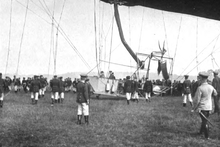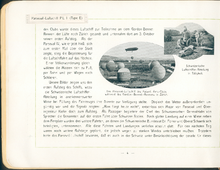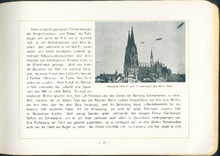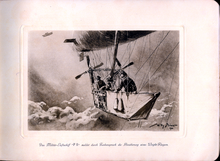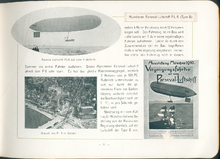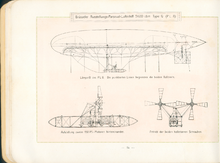List of Parseval airships
Under the name Parseval , a total of 22 airships were built between 1909 and 1919 under August von Parseval . Later on, some airships were built under the name Parseval-Naatz principle.
The ships were previously described with the male form. It was called: The Parseval, as it was also the case with the Zeppelins .
The Parseval airships up to PL 25 were impact airships , the following keel airships . According to their shape and structure, the ships were disparagingly referred to by the crews as rubber cows .
list
Experimental airship
- first trip on May 26, 1906 on the military grounds in Berlin Tegel
- Pilot: Captain von Krogh
- Length: 48.5 m, diameter: 4.8 m
- Drive: Daimler engine with 26 kW (35 PS)
- Top speed: 43.2 km / h
- The envelope was manufactured by the Riedinger balloon factory and later enlarged from 2,300 to 2,800 m³, the length increased to 50 m
- Only after completion of all modifications was it listed under the name "PL 1" from 1909
PL 1
- emerged from the test airship
- Maiden voyage: September 21, 1909
- Volume: 3,200 m³, 60 m long, 9.4 m diameter
- Drive: a Daimler engine with 62 kW (85 PS), a 4.25 m propeller
- Following three test drives on September 21 and 22, 1909 and improvements to the control system and the shape of the envelope, the PL 1 was transported by train to Zurich for the Gordon Bennet balloon race (four demonstration drives in Zurich).
- was operated in February 1910 for the Imperial Aero Club Airship and in Bitterfeld until its decommissioning
- 20 journeys between September 21, 1909 and April 21, 1910, the last journey ended with an emergency landing
- Experiments with a photo projector (see also PL 6)
PL 2 / PI
- built for the Prussian Army, there under the designation PI, construction similar to PL 1
- first trip: August 13, 1908, in use until 1912, then disarmed
- Volume: 4,100 m³
- Length: 60 m, diameter: 10.4 m
- Drive: A Daimler engine with 62 kW (85 PS) with a propeller
- Top speed: 47 km / h
- destroyed on landing during a storm on September 16, 1908 near Grünewald
PL 3 / P.II
- From March 23, after only 7 trips, the envelope was increased from 5,600 to 6,600 m³, refilling started on June 5, 1909, length remained at 70 m, diameter increased by one meter to 11.3 m, test run on June 28, 1909 in Bitterfeld
- Performed regular passenger trips with up to 7 passengers and 4 crew members at the International Aviation Exhibition in Frankfurt am Main (ILA) from August 7th to the end of October 1909. A total of 74 trips
- At the International Aviation Exhibition in Frankfurt am Main in 1909, a race between the Zeppelin LZ 6 and the PL 3 took place on September 15 . This race turned equally the culmination of the split in the airship world: while the Zeppelin -Luftschiffe as rigid airships were built, Parseval airships were a blimp constructed.
- On April 22, 1910, the airship took part in an air parade in front of Kaiser Wilhelm II in Bad Homburg vor der Höhe . Due to wind and rain, PL 3 did not return to Cologne until April 23 at 7 p.m., where it landed undamaged at around 1 a.m.
- Decommissioned after diving into the sea on May 16, 1910
- Drive: two NAG motors with 81 kW (110 PS) each, each driving a four-bladed propeller
- Top speed: 51 km / h
PL 4 - WED

- PL 4 was bought by the kuk military aeronautical establishment and stationed in Fischamend under the name "MI"
- First voyage: November 26, 1909
- Volume: 2,450 m³
- Drive: Austro-Daimler motors from Wiener Neustadt , either 1 × 62 kW or 2 × 33 kW (85 or 2 × 45 PS), each of which powered a propeller
- Cover from the Austrian rubber goods factory in Wimpassing ; 2 ballonets
- Length: 50 m, diameter 12.5 m
- Impact height: 1,000 m
- Crew: 2–3, passengers: 4–5 (capacity for a total of 7 people)
- disarmed 1913
PL 5
- Over 150 passenger trips
- On June 16, 1911 when the envelope was emptied in Hann. Münden destroyed by fire, was later replaced by PL 9.
- Volume: 1,450 m³
- Speed: 36 km / h
- Journey time 5 hours
- Climbing height: 1,000 m
- Crew and passengers: 3–4
PL 6 "Stollwerck"
- Tour and advertising airship
- first trip June 30, 1910
- up to 12 passengers
- First night system for aerial advertising on an airship, images could be projected onto the shell with a projector
- was modernized and enlarged in October 1912 in order to bring it to the same technical level as PL 12, including increased size from 6,800 to 8,000 m³
- Length: 70 m; later 75 m
- Diameter: 15 m
- Drive: 2 NAG motors with a total of 162 kW (220 PS) and two-bladed propellers
- Max. Speed: 56; after the modernization 59 km / h
- A total of 250 journeys and 2300 passengers and 15000 km were covered
PL 7 handle
- Delivered to Russia under the designation Grif (see: Russian airships )
- Volume: 6700 m³
- Speed: 14-15 m / s
- Travel time: ≥ 20 h
- Elevation: 2500 m
- Crew and passengers: 12-16
- Crew: 3–4
PL 8 replacement P.II
- Military acceptance on March 12, 1913 by the Prussian Army under the designation Replacement P.II
- Volume: 5600 m³
- Speed: 16-17 m / s
- Travel time: ≥ 20 h
- Elevation height: 2000 m
- Passengers and crew: 7–12
- Crew: 4
PL 9
- replaced the PL 5 burned in Hanover in Breslau
- Sold to the Turkish military in 1913
PL 10 sports airship
- 1,700 m³ "sports airship": dismantled after the first voyage in 1910 and stored in Bitterfeld
PL 11 - P.III
- first trip March 1, 1912, for the Prussian Army as P.III until mid-1914
PL 12 Charlotte
- Baptized "Charlotte",
- built for "Rheinisch-Westfälische Flug- und Sportplatz-Gesellschaft mbH Wanne-Herten", used there for tours
- first trip: May 11, 1912
- PL 12 was used as a passenger and advertising airship until 1914.
- 82 m long, 14 m diameter
- Drive: 2 NAG motors with 81 kW (110 PS) each
- Volume: 8,000 m³
- Top speed: 48 km / h
PL 13 Yuhi
- 1912 as Yuhi to Japan
PL 14 Burewestnik
- Delivered to Russia under the name Burewestnik
PL 15 - M 3
- went to Italy as M 3 in 1914
PL 16 - P.IV
- first trip: October 2nd, 1913,
- was given to the Prussian Army in mid-1914, where it was designated as P.IV
- was in service until March 24, 1916
- Volume: 9,600 m³
- Length: 84 m
- Diameter: 15.5 m
- Drive power: 264 kW
- Max. Speed 70 km / h
PL 17
- first trip December 30, 1912
- Delivered to Italy, served in the army there until 1915
PL 18 - No. 4th
- first trip: April 23, 1913
- 1913 to the British Navy, there under the name Parseval No. 4, the operation is described as very successful
- 80 m long, 15 m diameter, 8,800 m³
- Drive: two Maybach motors with 132 kW (180 PS) each, top speed 68 km / h
- Crew: two officers and seven men, radio and armament were installed
- Served as a patrol airship during World War I , decommissioned in July 1917.
PL 19
- PL 19 was supposed to be used by the British Navy as Parseval No. 5, but was put into service with the German Navy after the outbreak of war. In England, Vickers made three shells and two nacelles with identical specifications as replacements.
- first trip: August 30, 1914
- 92 m long, 15 m diameter, 10,000 m³
- Drive: two Maybach motors with 132 kW (180 PS) each, speed: 76 km / h,
- On January 25, 1915, after an attack voyage on Libau , it made an emergency landing due to damage by fire at sea, and the crew was taken prisoner by Russia
PL 20 to PL 24
PL 20 to PL 24 were not built.
PL 25
PL 26
When landing after the first voyage on October 26, 1915, there was an accident. The airship burned, people did not die.
- semi-rigid airship
- Length: 157 m
- Max. Diameter: 19.5 m
- Volume: 31,300 m³
- Top speed: 100 km / h
- Drive: four Maybach engines with 177 kW (240 PS) each
PL 27
PL 27 made its first voyage on March 8, 1917. The main difference to its predecessor PL 26 was the arrangement of the gondolas. Since it no longer met the increased military requirements, it was not used by the military and converted into a passenger airship in 1919 . However, it had to be dismantled in 1920 according to the provisions of the Versailles Treaty.
- Length: 157 m
- Max. Diameter: 19.5 m
- Volume: 31,300 m³
- Top speed: 100 km / h
- Drive: four Maybach engines with 177 kW (240 PS) each
- Payload: 18 t
(Parseval) Raab-Katzenstein RK 27
- Identifier D-RK27
- semi-rigid construction, August von Parseval only acted in an advisory capacity
- Advertising airship with the inscription Trumpf Chocolate
- built in Kassel by the Raab-Katzenstein-Flugzeugwerke
- first trip on May 4, 1929 in Kassel
- Volume 1,440 m³
- Length 40 m
- Impact height 1,000 meters
- Drive: two Anzani engines with 26 kW (35 PS) each
- Speed: 80 km / h
- Four people could be carried.
Parseval-Naatz PN 28

- Identification D-PN 28
- semi-rigid construction
- Length: 39.5 m
- Max. Diameter: 10.5 m
- second advertising airship with the inscription Trumpf-Schokolade
- built in Seddin / Pomerania by Berliner Wasser- und Luftfahrzeug GmbH
- first trip on June 6, 1929 in Berlin
- Volume: 1,800 m³
Parseval-Naatz PN 29
- Identification D-PN 29
- semi-rigid airship
- Advertising airship with the inscription Sidenhuset
- built in 1929 as D-PN 29 with a passenger capacity of 5 people
- Volume: 2,300 m³
- Length: 44 m, diameter: 10 m
- Drive: A Siemens Halske engine with 75 kW (100 PS)
- Top speed: 82 km / h
- Total travel time: around 600 hours in 200 journeys.
On May 21, 1930 PN 29 was given the Swedish name SE-ACG Sidenhuset . Sidenhuset was a very well-known women's boutique in Stockholm at the time. The lettering was also big on the cover. The owner was AB Luftskeppsreklam i Stockholm .
The main task was aerial advertising over the Stockholm exhibition “Stockholmsutställningen”, a large craft fair with around 4 million visitors from May 16 to September 30. After only a week, the parked ship was damaged by strong winds at night. The manufacturer flew in to examine the damage. It was decided to take the ship to Germany to be repaired there. During the crossing, the ship crashed on June 4, 1930 south of the island of Öland in the Baltic Sea. The crew was saved, but the ship sank in the sea.
Parseval - Naatz PN 30
PN 30 went under the name Odol as an advertising airship. In addition to the advertising flights, technical tests were also made with this airship. It was once attached to the anchor mast for 63 days without being damaged.
- Identification: D-PN 30
- Advertising airship with the inscription Odol
- Length: 46 m
- Max. Diameter: 10.8 m
- Volume: 2,600 m³
- Top speed: 80 km / h
- Motorization: Siemens & Halske with 160 HP
- first trip: July 1932
See also
literature
- JK Bock, B. Knauer: Lighter than air: transport and carrier systems . Verlag Frankenschwelle, Hildburghausen 2003, ISBN 3-86180-139-6 .
- Christian Fackeldey: Parseval in sight! jmb Verlag, Hannover 2016, ISBN 978-3-944342-76-4 .
- D. Haaland, HG Knäusel, G. Schmidt, J. Seifert: Lighter than air - balloons and airships. (= Deutsche Luftfahrt. Volume 26). Bernard & Graefe Verlag, Bonn 1997, ISBN 3-7637-6114-4 .
- Jürgen Seifert: The airship yard and the seaplane construction department of the Luft-Fahrzeug-Gesellschaft in Bitterfeld (1908–1920). Bitterfeld 1988, DNB 891060502 .
- G. Schmitt, W. Schwipps: Pioneers of early aviation. Gondrom Verlag , Bindlach 1995, ISBN 3-8112-1189-7 .
Individual evidence
- ↑ a b c d e f g h i j k l m n o p q r Ladislas d 'Orcy: D'Orcy's airship manual; an international register of airships with a compendium of the airship's elementary mechanics. The Century Co., New York 1917, pp. 107-113. (online at archive.org ; accessed October 6, 2016)
- ↑ J. Bleibler: Starrluftschiffprojekte in Germany 1908 to 1914. In: W. Meighörner (Ed.): Airships that were never built. Friedrichshafen 2002, ISBN 3-86136-076-4 , p. 39.
- ↑ a b c Ladislas d'Orcy: D'Orcy's airship manual; an international register of airships with a compendium of the airship's elementary mechanics. The Century Co., New York 1917, p. 55. (online at archive.org ; accessed October 7, 2016)
- ↑ a b www.earlyaeroplanes.com: Photo of PL 5 with description of the image ( Memento from June 4, 2016 in the Internet Archive )
- ↑ D. Haaland, HG Knäusel, G. Schmidt, J. Seifert: Lighter than air - balloons and airships. (= Deutsche Luftfahrt. Volume 26). Bernard & Graefe Verlag, Bonn 1997, ISBN 3-7637-6114-4 , p. 188.
- ↑ Seve Unger Mark: Airships: Misconceptions and Myths First Part of Three. (Version 3.10 updated on February 9th, 2005 at 2355 Zulu / UTC) ( Memento from December 10, 2005 in the Internet Archive )
Web links
- The first Austrian military steering balloon. - Takeover and test flights of the Austrian Parsival I. - Flight over Vienna .. In: Allgemeine Automobil-Zeitung , 10th year, No. 49 Volume II., December 5, 1909, SS 1–15 (online at ANNO ).


